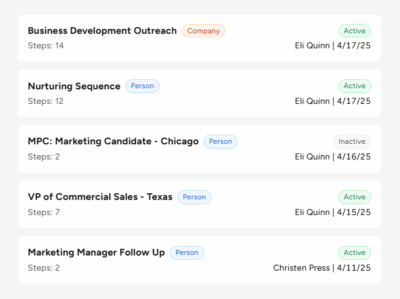In recruiting, relationships with candidates and clients help you make more quality placements. You can organize and develop connections through candidate relationship management. What is candidate relationship management?
What is candidate relationship management?
Candidate relationship management (CRM) is a strategic model for handling the candidate experience. With candidate relationship management, you can continuously attract and retain the best talent. CRM helps to shape your candidates’ impressions of and interactions with you.
Talent relationship management should extend throughout your recruitment process. From leads to hires, you need to foster long-term relationships with candidates. Following candidate relationship management best practices leads to strong relationships, and strong relationships lead to more placements.
Why candidate management in recruiting is important
As a recruiter, candidate relationship management helps you engage with talent on an ongoing basis. Long-term recruitment strategies help you maintain connections with every type of candidate. Your candidate pool will have multiple channels for sourcing.
With candidate management in recruiting, your pipeline consists of pre-screened candidates you can revisit. Recruiter-candidate relationships help you fill positions faster. When you are known and trusted by candidates, you have a better chance of filling job orders.
Candidate relationship management tools
You need to foster long-term relationships with your candidate pool to consistently secure talent. But, maintaining these connections can be difficult while keeping up with everyday tasks. That’s where candidate relationship management tools, like a recruitment management system, come in.
Customer relationship management tools help you communicate with your clients and candidates. By using CRM software, you can increase production and streamline your workflow. Here are some common functions of a recruiting CRM:
- Schedule events, such as phone calls, emails, and interviews
- Record notes about job orders and candidates
- Set up reminders
- Manage email marketing
- Import and track recruiting data
To improve your recruiting process even more, you can pair a CRM with an applicant tracking system, or ATS. What is an ATS going to do for your organization? Applicant tracking software helps you source and organize candidates. Usually, an ATS includes resume parsing, which extracts data from resumes and compiles it into a uniform format. You can also import spreadsheets, so all your data is in one location.
Together, ATS and CRM solutions make up recruiting software. Use an applicant tracking system to find candidates and a CRM to create long-term relationships.
Benefits of candidate relationship management
Candidate relationship management is key for recruiting talent. Here are a few benefits of implementing CRM strategies.
1. Manage candidate pipeline
Because of the nature of the hiring process, your candidates are often in different stages of the job placement process. A successfully placed candidate will advance through your pipeline like this:
- Becomes a lead
- Is contacted
- Goes through the interview process
- Receives an offer
- Is hired by the client
A candidate pipeline is not a static list of job seekers. It constantly changes as you discover new candidates and place job seekers. As candidates progress through your talent pipeline, you need to add more qualified applicants.
You don’t just want to hustle candidates through your pipeline. Candidate relationship management helps create a continuous inflow and outflow of candidates. You form long-term connections with past, current, and future candidates.
CRM automation helps you connect with applicants and speed up the recruiting process. A CRM solution lets you measure and sort candidates’ levels of interest. You can also categorize candidate skills, experience, and education.
2. Expand talent channels
Talent relationship management improves how you use recruitment channels. There are many places you can source quality candidates. You might find applicants on job posting boards, social media, or through recruiting referrals.
When you use candidate relationship management, you can’t hide behind your computer screen waiting for qualified job seekers to find you. You must make meaningful interactions with candidates to form relationships.
Don’t be afraid to take a creative approach in your recruitment sourcing strategies. Networking to potential candidates on multiple channels will grow your candidate pool. Interacting with current candidates will foster trust. Your CRM solution can organize talent channels and develop candidate relationships.
3. Maintain passive candidates
Some candidates are more active job searchers than others. Those who are not actively looking for work are called passive candidates. Passive candidates can be key in successful recruiting.
A 2016 LinkedIn report revealed that 68% of working professionals in the world are considered passive candidates, while only 32% are actively looking for a job.
Passive candidates are especially valuable for industries that require specialized skills. These niche positions have smaller candidate pools. You must source hard-to-find candidates and convince them to accept job offers.
Candidate relationship management makes it easier to recruit passive candidates. You have already established relationships with talent, so it’s easier to reach out to them. Your CRM solution organizes qualified candidates in your recruiting database. Old candidates stay in your pool, so you don’t need to constantly establish new relationships.









